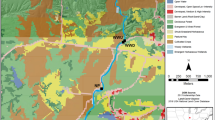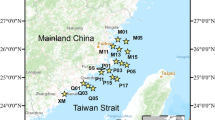Abstract
Sediment–water interfaces (SWIs) in lakes and reservoirs harbor diverse assemblages of heterotrophic bacteria that influence organic matter cycling. Seasonal reservoir mixing and stratification affect the rate and type of dissolved organic carbon (DOC) utilized by SWI bacteria, however these seasonal carbon utilization dynamics remain poorly understood. We conducted an exploratory multi-seasonal study using Biolog EcoPlates to measure SWI bacterial carbon substrate utilization rates (CSURs) and patterns in a monomictic eutrophic reservoir. Principal components analysis (PCA) was used to elucidate seasonal CSUR variation. Carbohydrate utilization was greatest during early (onset of) stratification and also was high during winter mixing. Amino acid utilization was greatest during late (prolonged) stratification. Carboxylic acids had greatest utilization during late stratification, but also had moderate to high utilization during all other seasons. Amines and polymers exhibited moderate utilization during all seasons. We related seasonal variation in these CSURs to SWI bacterial abundance, temperature, dissolved oxygen, and redox potential. Collectively these environmental variables accounted for 49.4–62.3% of the total substrate utilization variance by season. Several individual substrate CSURs were significantly (P < 0.05) positively and/or negatively correlated with individual environmental variables, with l-asparagine and putrescine exhibiting significant positive and negative correlations with every measured environmental variable. Lastly, seasonal changes in CSURs corresponded to various changes in SWI bacterial assemblage composition, with highest similarities among early stratification and autumnal overturn assemblages and lowest similarities among late stratification and winter mixing assemblages.


Similar content being viewed by others
References
Atlas, R. M. & R. Bartha, 1998. Microbial Ecology: Fundamentals and Applications, 4th ed. Benjamin Cummings, Menlo Park.
Austen, M. C., P. J. D. Lambshead, P. A. Hutchings, G. Boucher, P. V. R. Snelgrove, C. Heip, G. King, I. Koike & C. Smith, 2002. Biodiversity links above and below the marine sediment–water interface that may influence community stability. Biodiversity and Conservation 11: 113–136.
Bertilsson, S. & L. J. Tranvik, 2000. Photochemical transformation of dissolved organic matter in lakes. Limnology and Oceanography 45: 753–762.
Bloesch, J., 2004. Sedimentation and lake sediment formation. In O’Sullivan, P. E. & C. S. Reynolds (eds), The Lakes Handbook: Volume 1 Limnology and Limnetic Ecology. Blackwell, Malden.
Boudreau, B. P. & B. B. Jørgensen, 2001. The Benthic Boundary Layer: Transport Processes and Biogeochemistry. Oxford University Press, New York.
Brugger, A., B. Reitner, I. Kolar, N. Quéric & G. J. Harndl, 2001. Seasonal and spatial distribution of dissolved and particulate organic carbon and bacteria in the bank of an impounding reservoir on the Enns River, Austria. Freshwater Biology 46: 997–1016.
Butorin, A. N., 1989. The number and activity of microorganisms at the sediment water interface of lakes. Archiv für Hydrobiologie Beihefte Ergebnisse der Limnologie 33: 259–163.
Chin-Leo, G., 2002. Bacterial secondary productivity. In Hurst, C. J., R. L. Crawford, G. R. Knudsen, M. J. McInerney & L. D. Stetzenbach (eds), Manual of Environmental Microbiology, 2nd ed. ASM Press, Washington, D.C.
Choi, K. & F. C. Dobbs, 1999. Comparison of two kinds of biolog microplates (GN and ECO) in their ability to distinguish among aquatic microbial communities. Journal of Microbiological Methods 36: 203–213.
Christian, B. W., C. N. Early & O. T. Lind, 2002. Factors affecting bacterioplankton size and abundance in anoxic hypolimnia. Verhandlungen Internationale Vereinigung für theoretische und angewandte Limnologie 28: 705–709.
Christian, B. W. & O. T. Lind, 2006. Key issues concerning biolog use for aerobic and anaerobic freshwater bacterial community-level physiological profiling. International Review of Hydrobiology 91: 257–268.
Christian, B. W. & O. T. Lind, 2007. Increased sediment–water interface bacterial [3H]-l-serine uptake and biomass production in a eutrophic reservoir during summer stratification. Archiv für Hydrobiologie (in press).
Cole, J. J. & M. L. Pace, 1995. Bacterial secondary production in oxic and anoxic freshwaters. Limnology and Oceanography 40: 1019–1027.
Danovaro, R., N. D. Croce & M. Fabiano, 1998. Biochemical composition of particulate organic matter and bacterial dynamics at the sediment–water interface in a Mediterranean seagrass system. Hydrobiologia 363: 241–251.
Dean, W. E., 1999. The carbon cycle and biogeochemical dynamics in lake sediments. Journal of Paleolimnology 21: 375–393.
Ding, H. & M. Sun, 2005. Biogeochemical degradation of algal fatty acids in oxic and anoxic sediment–seawater interface systems: effects of structural association and relative roles of aerobic and anaerobic bacteria. Marine Chemistry 93: 1–19.
Gantzer, C. J. & H. G. Stefan, 2003. A model of microbial activity in lake sediments in response to periodic water-column mixing. Water Research 37: 2833–2846.
Garland, J. L., 1997. Analysis and interpretation of community-level physiological profiles in microbial ecology. FEMS Microbiology Ecology 24: 289–300.
Grover, J. P. & T. H. Chrzanowski, 2000. Seasonal patterns of substrate utilization by bacterioplankton: case studies in four temperate lakes of different latitudes. Aquatic Microbial Ecology 23: 41–54.
Heinen, E. A. & J. McManus, 2004. Carbon and nutrient cycling at the sediment–water boundary in western Lake Superior. Journal of Great Lakes Research 30(Supplement 1): 113–132.
Hodell, D. A. & C. L. Schelske, 1998. Production, sedimentation, and isotopic composition of organic matter in Lake Ontario. Limnology and Oceanography 43: 200–214.
Hollibaugh, J. T. & F. Azam, 1983. Microbial degradation of dissolved proteins in seawater. Limnology and Oceanography 28: 1104–1116.
Hulbert, M. H., R. H. Bennett, R. J. Baerwald, R. L. Long, K. J. Curry, A. L. Curry & M. T. Abril, 2002. Observations of the sediment–water interface: marine and fresh water environments. Marine Georesources and Geotechnology 20: 255–274.
Jahnke, R. A. & D. B. Craven, 1995. Quantifying the role of heterotrophic bacteria in the carbon cycle: a need for respiration rate measurements. Limnology and Oceanography 40: 436–441.
Lepš, J. & P. Šmilauer, 2003. Multivariate Analysis of Ecological Data Using CANOCO. Cambridge University Press, Cambridge, UK.
Liikanen, A. & P. J. Martikainen, 2003. Effect of ammonium and oxygen on methane and nitrous oxide fluxes across the sediment–water interface in a eutrophic lake. Chemosphere 52: 1287–1293.
Lind, O. T. & L. Dávalos-Lind, 1991. Association of turbidity and organic carbon with bacterial abundance and cell size in a large, turbid, tropical lake. Limnology and Oceanography 36: 1200–1208.
Lindstrom, J. E., R. P. Barry & J. F. Braddock, 1998. Microbial community analysis: a kinetic approach to constructing potential c source utilization patterns. Soil Biology and Biochemistry 30: 231–239.
Madigan, M. T., J. Martinko & J. Parker, 1997. Brock Biology of Microorganisms, 8th ed. Prentice Hall, New Jersey.
Mills, A. L. & J. L. Garland, 2002. Application of physiological profiles to assessment of community properties. In Hurst, C. J., R. L. Crawford, G. R. Knudsen, M. J. McInerney & L. D. Stetzenbach (eds), Manual of Environmental Microbiology, 2nd ed. ASM Press, Washington D.C.
O’Loughlin, E. J. & Y. Chin, 2004. Quantification and characterization of dissolved organic carbon and iron in sedimentary porewater from Green Bay, WI, USA. Biogeochemistry 71: 371–386.
Peres-Neto, P. R., D. A. Jackson & K. M. Somers, 2003. Giving meaningful interpretation to ordination axes: assessing loading significance in principal component analysis. Ecology 84: 2347–2363.
Pettine, M., L. Patrolecco, M. Manganelli, S. Capri & M. G. Farrace, 1999. Seasonal variations of dissolved organic matter in the northern Adriatic Sea. Marine Chemistry 64: 153–169.
Porter, K. G. & Y. S. Feig, 1980. The use of DAPI for identifying and counting aquatic microflora. Limnology and Oceanography 25: 943–948.
Preston-Mafham J., L. Boddy & P. F. Randerson, 2002. Analysis of microbial community functional diversity using sole-carbon-source utilisation profiles—a critique. FEMS Microbiology Ecology 42: 1–14.
Qu, W., R. J. Morrison, R. J. West & C. Su, 2005. Diagenetic stoichiometry and benthic nutrient fluxes at the sediment–water interface of Lake Illawarra, Australia. Hydrobiologia 537: 249–264.
Rosenstock, B. & M. Simon, 2003. Consumption of dissolved amino acids and carbohydrates by limnetic bacterioplankton according to molecular weight fractions and proportions bound to humic matter. Microbial Ecology 45: 433–443.
Rosenstock, B., W. Zwisler & M. Simon, 2005. Bacterial consumption of humic and non-humic low and high molecular weight DOM and the effect of solar irradiation on the turnover of labile DOM in the southern ocean. Microbial Ecology 50: 90–101.
Sala, M. M., J. Pinhassi & J. M. Gasol, 2006. Estimation of bacterial use of dissolved organic nitrogen compounds in aquatic ecosystems using Biolog plates. Aquatic Microbial Ecology 42: 1–5.
Seiter, K., C. Hensen & M. Zabel, 2005. Benthic carbon mineralization on a global scale. Global Biogeochemical Cycles 19: GB1010.
Sinsabaugh, R. L., S. Findlay, P. Franchini & D. Fischer, 1997. Enzymatic analysis of riverine bacterioplankton production. Limnology and Oceanography 42: 29–38.
Song, J., Y. Luo, Q. Zhao, P. Christie, 2004. Microcosm studies on anaerobic phosphate flux and mineralization of lake sediment organic carbon. Journal of Environmental Quality 33: 2353–2356.
Stumm, W., 2004. Chemical processes regulating the composition of lake waters. In O’Sullivan, P. E. & C. S. Reynolds (eds), The Lakes Handbook: Volume 1 Limnology and Limnetic Ecology. Blackwell, Malden.
Sweerts, J. R. A., M. Bär-Gilissen, A. A. Cornelese & T. E. Cappenberg, 1991. Oxygen consuming processes at the profundal and littoral sediment–water interface of a small meso-eutrophic lake (Lake Vechten, The Netherlands). Limnology and Oceanography 36: 1124–1133.
ter Braak, C. J. F. & P. Šmilauer, 2002. CANOCO Reference Manual and CanoDraw for Windows User’s Guide: Software for Canonical Community Ordination (Version 4.5). Microcomputer Power, Ithaca, NY.
Tranvik, L. J., H. Olofsson & S. Bertilsson, 1999. Photochemical effects on bacterial degradation of dissolved organic matter in lake water. In Bell, C. R., M. Brylinsky & P. Johnson-Green (eds), Microbial Biosystems: New Frontiers, Proceedings of the 8th International Symposium on Microbial Ecology. Atlantic Canada Society for Microbial Ecology, Halifax.
Vreča, P., 2003. Carbon cycling at the sediment–water interface in a eutrophic mountain lake (jezero na planini pri jezeru, slovenia). Organic Geochemistry 34: 671–680.
Wirtz, K. W., 2003. Control of biogeochemical cycling by mobility and metabolic strategies of microbes in the sediments: an integrated model study. FEMS Microbiology Ecology 46: 295–306.
Acknowledgements
This work was made possible by the Jack G. and Norma Jean Folmar Research Grant, Baylor University. We thank Dr. Rene Massengale for the use and instruction of the Biolog Microstation and related equipment. We also thank Dr. Ryan King and Dr. Darrell Vodopich for statistical assistance and manuscript criticism. Valuable assistance in field collection was provided by Christopher Filstrup and David Clubbs.
Author information
Authors and Affiliations
Corresponding author
Additional information
Handling editor: D. Ryder
Rights and permissions
About this article
Cite this article
Christian, B.W., Lind, O.T. Multiple carbon substrate utilization by bacteria at the sediment–water interface: seasonal patterns in a stratified eutrophic reservoir. Hydrobiologia 586, 43–56 (2007). https://doi.org/10.1007/s10750-006-0476-6
Received:
Revised:
Accepted:
Published:
Issue Date:
DOI: https://doi.org/10.1007/s10750-006-0476-6




